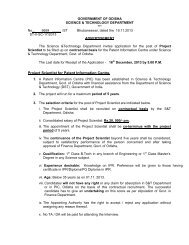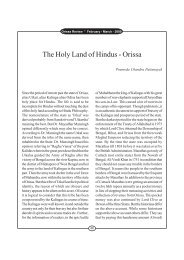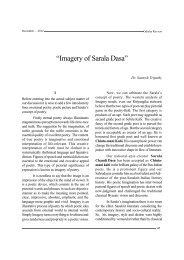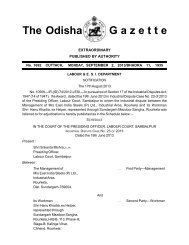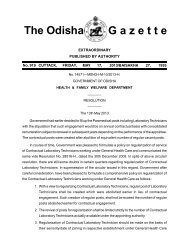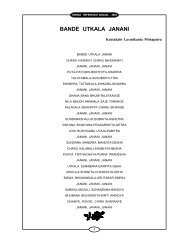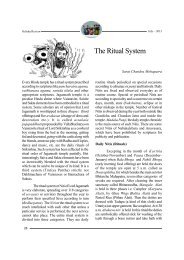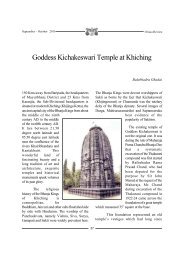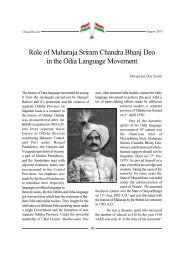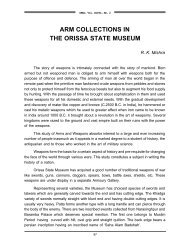Daily Rituals of Sri Jagannath Temple
Daily Rituals of Sri Jagannath Temple
Daily Rituals of Sri Jagannath Temple
You also want an ePaper? Increase the reach of your titles
YUMPU automatically turns print PDFs into web optimized ePapers that Google loves.
Orissa Review<br />
22<br />
<strong>Daily</strong> <strong>Rituals</strong> <strong>of</strong> <strong>Sri</strong> <strong>Jagannath</strong> <strong>Temple</strong><br />
<strong>Jagannath</strong> is a highly humanized<br />
deity. The gap between men and<br />
Divine has been bridged in <strong>Jagannath</strong><br />
cult. Like daily happenings and dayto-day<br />
activities <strong>of</strong> a common man He<br />
brushes His teeth, takes bath, changes<br />
His clothes, wears varieties <strong>of</strong> colorful<br />
dresses, adorns in definite time<br />
intervals, enjoys 56 varieties <strong>of</strong> food<br />
items, goes to bed and takes rest after<br />
light night meals. Different modus<br />
operandi <strong>of</strong> human life have emerged<br />
within His cult to give it a unique<br />
statute. In such context the daily rituals<br />
<strong>of</strong> <strong>Jagannath</strong> temple are discussed chronologically.<br />
Dwarfita and Mangal Arati — The first ritual<br />
<strong>of</strong> the day is ceremonial opening <strong>of</strong> the doors,<br />
scheduled time for opening <strong>of</strong> the doors is 5 AM.<br />
or before that. On some specific occasions, such<br />
as - Aswina Ekadasi (next day after Dasahara)<br />
to Kartik Purnima and from Dhanu Sankranti to<br />
Makar Sankranti Dwarfita time is from 2 AM to<br />
3 AM in the morning. For this simple opening <strong>of</strong><br />
the doors, presence <strong>of</strong> 5 Sevayats is necessary;<br />
they are Bhitarchu Mahapatra; Pratihari; Muduli;<br />
Akhanda Mekap and Palia Mekap. After scrutiny<br />
<strong>of</strong> the seal on the padlock given in previous night;<br />
Muduli opens the Jay-Vijay dwar. Thereafter<br />
Kalahat or Chamu Dwar is opened. Pratihari<br />
Padmanabha Mohapatra<br />
utters the words Manima and Manima while the<br />
doors are opened. After opening <strong>of</strong> all the doors<br />
the inner part <strong>of</strong> the temple is purified in sacred<br />
water.<br />
The most important ritual in the early<br />
morning is Mangal Arati. Morning Aratrikam <strong>of</strong><br />
Lord <strong>Jagannath</strong> is done by Bhitarchu Mahapatra.<br />
In front <strong>of</strong> Balabhadra and Maa Subhadra it is<br />
done by 2 Puspalakas. lnitially Camphor<br />
Aratrikam is made in specially designed brass and<br />
bronze-stands and it is known as Karpur Alati. A<br />
lamp with twenty one weeks is lit thereafter,<br />
followed by Pistak Alati. The ashes after Arati<br />
are distributed as Prasad.<br />
July - 2011
12 Sevayats are involved for Aratrikam;<br />
they are Bhitarachu Mahapatra; Pratihari; Muduli;<br />
Akhanda Mekap; Palia Mekap; Khat-seja<br />
Mekap; Palia Suarbadu; Khuntia; Garabadu;<br />
Balitabala; Puspalak and one temple civilian<br />
employee Mangala Arati can be seen by pilgrims;<br />
just in front <strong>of</strong> the Bhitar Kath Argali; free <strong>of</strong> cost.<br />
Mailam — change <strong>of</strong> dress —After Mangal<br />
Arati the next ritual is Mailam or removal <strong>of</strong> the<br />
dresses and floral decorations <strong>of</strong> the previous<br />
evening. The scheduled time for Mailam is 6 AM<br />
but it is generally done after completion <strong>of</strong> Mangal<br />
Arati. The Sevayats involved for this purpose are<br />
- 3 Puspalaks; Khuntia; Changada Mekap and<br />
Dhoba (but he is a Brahmin). All three Puspalaks<br />
go up to the Ratna Simhasan; remove the<br />
decorations; dresses and flowers <strong>of</strong> the deities<br />
and dress them with Tadap and Uttariya. The<br />
dresses removed are washed daily by a Sevayat<br />
named Dhoba; but he is not Dhoha by caste.<br />
Clothes utilised during Mailam are 4 Tadaps, one<br />
for each deity; 2 Uttariyas, one for <strong>Jagannath</strong> and<br />
the other one for Balahhadra. At the time <strong>of</strong><br />
Mailam flowers; Tulasi etc. are removed; those<br />
are equally distributed between Khuntia and<br />
Puspalak, for further distribution as Prasad to the<br />
devotees.<br />
Abakash — Ahakash is the morning ablution <strong>of</strong><br />
the deities just like human beings, this includes<br />
cleaning <strong>of</strong> the teeth; scrapping <strong>of</strong> the tongue <strong>of</strong><br />
the deities and thereafter giving them a pleasant<br />
bath symbolically. The scheduled time for Abkash<br />
is 6 AM to 6.30 AM. Abkasha puja is done by 3<br />
Puspalaks below the Simhasan. S<strong>of</strong>t twig and<br />
tongue-cleaner are shown to deities with<br />
appropriate Mudras as if they do brush.<br />
Thereafter, along with chanting <strong>of</strong> Vedic Suktas;<br />
water mixed with camphor; Aamla; sandalpaste;<br />
milk and curd are poured on the reflection <strong>of</strong> the<br />
deities on bronze mirrors placed in front <strong>of</strong> them<br />
July - 2011<br />
Orissa Review<br />
and it is considered as if they take their bath. It is<br />
actually a Mantra Snana. Then the Astrologer<br />
(Khuri Nayak) explains about the Tithi and other<br />
astrological details <strong>of</strong> the day. On the specific<br />
occasion <strong>of</strong> birthday <strong>of</strong> any deity, Nakhyatra<br />
Bandapana is also undertaken.<br />
The Sevayats engaged for the purpose<br />
are — Puspalak; Suar Badu; Pani-apat; Khatuli<br />
Sebak; Darpania; Mukha Pakhal Padhiari;<br />
Mukha Pakhal Pasupalak; Aanla Ghatuari;<br />
Bhandar Mekap; Mahabhoi; and <strong>Temple</strong><br />
Astrologer. The materials required are — wooden<br />
cot; purified water; Khatuli; s<strong>of</strong>t twigs; tonguecleaners;<br />
three vessels; flower; tulasi; bronze<br />
mirrors and water storage materials.<br />
The bathing <strong>of</strong> Garuda in the Nata Mandap follows<br />
that <strong>of</strong> the principal deities. Garuda Sevak brings<br />
Chunera water and undertakes the bath <strong>of</strong> <strong>Sri</strong><br />
Garuda. The bath water <strong>of</strong> the deities and that <strong>of</strong><br />
Garuda is considered as Prasad and invariably<br />
useful for the patients. During Abakash rites; public<br />
are not allowed to enter into the sanctum, but they<br />
can have a glimpse <strong>of</strong> the deities, standing just in<br />
front <strong>of</strong> the Bhitara Kath Argali’. After Abakash<br />
the deities are dressed with Baralagi Khanduas.<br />
Then Akhand Mekap places perpetual lamp<br />
(Akhanda Baitha) near the Simhasan, which<br />
remains burning for whole day and night.<br />
Sahana Mela — Public Darshan for one hour<br />
normally the scheduled time is from 7AM to 8AM<br />
but it varies at times depending on completion <strong>of</strong><br />
earlier programmes. The deities <strong>of</strong>fer a clear<br />
Darshan to their adoring devotees, but devotees<br />
are not allowed to touch the deities. From Ekadasi<br />
after Dasahara till Kartik Purnima, the timing <strong>of</strong><br />
Sahanmela is shifted to the evening i.e. after<br />
completion <strong>of</strong> the Dwipahar Dhoop. The timing<br />
for Sahanamela is subject to change, consequent<br />
on change <strong>of</strong> specific programmes on important<br />
functions on festive occasions.<br />
23
Orissa Review<br />
Beshalagi is taken up after public<br />
Darshan. The deities are clad with different<br />
apparels; ornaments and flowers etc. based on<br />
availability <strong>of</strong> materials and flowers etc. Beshalagi<br />
is done by the Puspalak Sevaks.<br />
Rosh Homa; Surya Puja; Dwarpal and<br />
Garuda Puja — The next ritual carried out is<br />
Fire Sacrifice in the temple kitchen near the Kotha<br />
Chuli before initiation <strong>of</strong> the cooking process for<br />
the day. As per the record <strong>of</strong> rights it is the duty<br />
<strong>of</strong> the Deula Purohit but this work is being<br />
performed by the Pujapandas at present. Worship<br />
<strong>of</strong> Sun God or Surya Puja is done just after<br />
completion <strong>of</strong> Rosh Homa by the same sevayats<br />
in Surya temple; situated near the Muktimandap.<br />
Dwarpal Puja is the <strong>of</strong>fering <strong>of</strong> prayers and Bhog<br />
to the celestial doorkeepers. Jay and Bijaya in<br />
front <strong>of</strong> the Jay Bijaya door, performed by the<br />
Palia Pujapanda. Garuda Puja i.e Puja <strong>of</strong> the<br />
Charioteer follows, thereafter.<br />
Gopal Ballav Bhoga Puja — This is the<br />
breakfast <strong>of</strong> the deities and the scheduled time is<br />
9AM. This Bhoga is served in Anabasra Pindi<br />
outside the sanctum. Puja is undertaken by the<br />
Pujapandas in Panchopchar system. The items<br />
<strong>of</strong>fered are Paga Khai; coconut-sugar-plum;<br />
sweet bananas; Khuarnanda curd: butter and small<br />
coconut pieces etc. The Sevayats involved during<br />
this puja are 3 Pujapandas: Sudu Suar;<br />
Ballavjogania; Charcha Paika; Suarbadu;<br />
Patribadu; Garabadu; Palia Mahasuar and<br />
Pradhani. During Dhanu Masa, (which falls during<br />
December and January) Ballav Bhoga and Pahili<br />
Bhoga are taken up together. Similarly, on<br />
Dolapurnima and Snanapurnami Ballav and Sakal<br />
dhoop are taken up together.<br />
Sakal Dhoopa — Regular morning food <strong>of</strong>fering<br />
is known as Sakal dhoop, its scheduled time is<br />
10 AM and the place for the puja is Pokharia.<br />
24<br />
The system <strong>of</strong> Puja is Sodasa Upacara. 3<br />
Pujapandas sit on the Ratna Simhasan to take up<br />
the Puja; except for the period from Odhana Sasthi<br />
to Basanta Panchami; during such period<br />
Pujapandas sit below the Ratna Sirnhasan to take<br />
up Puja.<br />
The items <strong>of</strong>fered are — Kanika; Tata<br />
Khechudi; Lukhura Khechudi; Mendha mundia;<br />
Bada kanti; Sana kanti; Mathpuli; Hansapuli; Pitha<br />
puli; Chanda puli; Jhili; Enduri; Adapachidi; Saga<br />
and Bhaja etc.<br />
32 varieties <strong>of</strong> Sevavats such as<br />
Suarbadu; Dhukudidwar Pratihari; Paniapat;<br />
Pradhani Sevak; Pujapanda; Pratihari; Palia<br />
Mahasuar; Pantibadu; Rosh Paika; Palia Patri;<br />
Garahadu; Changada Mekap; Patribadu; Muduli;<br />
Chandan Ghatuari; Parikha Badu; Palia Mekap;<br />
Parikhya [Rajguru]; Palia Mahari; Palia Madeli;<br />
Jhanjapitali; Hadapa Nayak; Bidiajogania; Bojhia;<br />
Sudu Suar; Puran Panda; Gochikar; Dakhina<br />
Dwar Padhiari; Dwari Nayak; Ghantua and<br />
Bajantri; render their assistance during the Sakal<br />
Dhoopa.<br />
The materials required for preparation <strong>of</strong><br />
items due for <strong>of</strong>fering are supplied by the <strong>Temple</strong><br />
Administration and some other Maths. The items<br />
are prepared by Kothbhog Supakars; such<br />
Prasads are required to be distributed to the<br />
temple Sevayats; which is otherwise called as<br />
‘Khei’; for the services rendered by them in the<br />
temple.<br />
Mailam — Bhogamandap - After the Sakal<br />
Dhoop again mailam and change <strong>of</strong> dresses are<br />
undertaken. Then the second round Dhoop <strong>of</strong> the<br />
deities are arranged within the Bhogamandop<br />
behind the Garud Stambha, its scheduled time is<br />
11 AM. The materials used and the expenditure<br />
incurred for this bhog is not met by the temple<br />
administration. Prasad in huge quantities is <strong>of</strong>fered<br />
July - 2011
in Bhogamandap to meet the requirements <strong>of</strong> the<br />
pilgrims and the local people. Puja is done by<br />
three Pujapandas under Panchopachar system.<br />
There is no specification <strong>of</strong> items and no restriction<br />
<strong>of</strong> quantities to be <strong>of</strong>fered; Prasad is cooked by<br />
Supakars based on the assessment <strong>of</strong> pilgrims<br />
expected to visit on a particular day and<br />
requisitions obtained from the public. Mahaprasad<br />
out <strong>of</strong> Bhogamandap Puja are meant for public<br />
sale only. The Sevayats who assist in this Puja<br />
are Palia Puspalak; Changada Mekap; Palia<br />
Mekap; Bhogamandop Pratihari; Suar Badu;<br />
Bhogamandap Dwar Pratihari; Suar; Mahasuar;<br />
Mekap Khuntia; Patri Badu; Garabadu and<br />
Charchabala.<br />
Madhyahna Dhoop — This is the mid-day meal<br />
<strong>of</strong> the deities and the scheduled time is 12.30 to<br />
1 PM; the place for the Puja is Pokharia below<br />
the Simhasan; the system <strong>of</strong> Puja is<br />
Sodashopachar. 3 Pujapandas sit on the Ratna<br />
Simhasan to take up the Puja; same Sevayats<br />
engaged in Sakal Dhoop are also involved in this<br />
Dhoop. Materials used for preparation <strong>of</strong> Prasad<br />
are provided by temple administration.<br />
Mainly the items <strong>of</strong>fered are—arisha;<br />
pitha puli; tipuri; mathpuli: kakara; chadheilada;<br />
tata manohar; khairachula: marichaladu; pheni;<br />
takua; gaja; biribadi; anna; mugadali; pitianna; oria;<br />
marichapani; khiri; subashpakhal; sakara and pana<br />
etc.<br />
On completion <strong>of</strong> the bhog Arati is<br />
performed.<br />
Madhyahna Pahuda — After the Dhoop; the<br />
prescribed item is Madhyahna Pahuda; rest for<br />
sometime; but now a days either the deities do<br />
not like to take rest or rest is not considered to<br />
be provided; for their sound health. But as a<br />
matter <strong>of</strong> procedure Pahuda is due after the midday<br />
meal. However the system <strong>of</strong> Pahuda is —<br />
July - 2011<br />
Orissa Review<br />
that after Madhyahna Dhoop another Mailam and<br />
change <strong>of</strong> dresses etc. are to be done by the<br />
Puspalaks. Four beds i.e Ratna Palankas are to<br />
be brought; arranged and kept below the<br />
Simhasan by Khatseja Mekap. Badadwar<br />
Padhiari invites the deities Manima Manima; please<br />
come down from Ratna Simhasan and take rest<br />
on ‘Ratna Palankas.’ Thereafter the Kalahat;<br />
Beharan and Jay-Bijay doors remain closed. The<br />
time for opening <strong>of</strong> the doors is 6 PM.<br />
This Pahuda is being operated only for a<br />
few days in the months <strong>of</strong> Kartika and Pausha<br />
(Pahilibhoga period). The system is generally<br />
being ignored due to delay in daily programme.<br />
Sandhya Arati — Evening Arati <strong>of</strong> <strong>Sri</strong> <strong>Jagannath</strong><br />
is done by Talachhu Mahapatra, Aratis <strong>of</strong> <strong>Sri</strong><br />
Balabhadra and <strong>Sri</strong> Subhadra is done by two<br />
Puspalakas. Camphor Arati; 21 candles and<br />
Sanjakali Arati is done by the Sevayats; standing<br />
below the Simhasan in front <strong>of</strong> the deities. On the<br />
days when Madhyahna Pahuda is arranged;<br />
change <strong>of</strong> dresses and decorations are made after<br />
evening Arati; the same procedure is followed on<br />
all Ekadasi days; but when Pahuda is not<br />
practicable; change <strong>of</strong> dresses etc. are made<br />
before the evening Arati.<br />
The Sevayats engaged are Bhitarchu<br />
Mahapatra; Paliamekap; Akhandamekap;<br />
Muduli; Khatsejmekap; Palia Pusupalak;<br />
Garabadu; Talicha Mahapatra and Khuntia.<br />
Sandhya Dhoop — This is the evening tiffin <strong>of</strong><br />
the deities and the scheduled time is 7 to 8 PM;<br />
the place <strong>of</strong> Puja is Pokharia below the<br />
Ratnasimhasan; the system is Sodasopachar and<br />
the Prasad is arranged on behalf <strong>of</strong> the <strong>Temple</strong><br />
Administration. The Sevayats who are engaged<br />
in Sakal and Madhyahna dhoop perform this<br />
Dhoop also.<br />
25
Orissa Review<br />
The items <strong>of</strong>fered to the deities are kaanla<br />
puli; takua; mathpuli; bhog pitha; gotali; bada<br />
kakara; sana kakara; luna khuruma; amalu; suar<br />
pitha; rosh paika hiribuha; jhadeinada; subash<br />
pakhal, sana and bada kadamba etc.<br />
After this Dhoop Arati is done by three<br />
Pujapandas in three silver pots; five varieties <strong>of</strong><br />
Aratis are made. This Arati is named as<br />
Jayamangal Arati; Arati for the betterment <strong>of</strong> the<br />
universe.<br />
The next item is Sahan Mela; this Niti is<br />
not being observed at present. The system is just<br />
like the Sahanmela performed in morning time.<br />
Mailam and Chandanalagi — After Sandhya<br />
Dhoop the dresses <strong>of</strong> the deities are changed.<br />
Before the colourful late night Badasimhar Vesha,<br />
the deities are smeared with sandalpaste, mixed<br />
with musk and camphor, this is known as<br />
Chandanlagi, its scheduled time is 10 PM.<br />
Sevayats involved in this programme are<br />
Suar badu; Puspalak; Ghatuari; Muduli;<br />
Paliamekap; Palia Padhiari; Garabadu;<br />
Hadapnaik and Palia Khuntia.<br />
Badasimhar Vesha and Badasimhar Dhoop<br />
— Amongst all the daily rituals, the most attractive<br />
is the Badasimhar Vesha. During this ritual<br />
Chaturddhamurti look enchanting in their grand<br />
make-up. Badasimhar Vesha is a colourful floral<br />
decoration with special items like karapallab;<br />
kundal; tadiga and chandrika etc. The deities are<br />
clad with Barlagi Patas, traditional Orissan tie and<br />
dye cloths (silk clothes) Jaydev’s Gitagovind<br />
Slokas woven into them. This is the most beautiful<br />
and smiling appearance <strong>of</strong> the deities; after which<br />
they take slight light foods and go to their<br />
respective beds.<br />
26<br />
Badasimhar Dhoop is the last Bhog <strong>of</strong><br />
the day and the scheduled time is 11.15 PM. Three<br />
Pujapandas below the Ratna Simhasan <strong>of</strong>fer the<br />
Puja with Panchopachar. The items <strong>of</strong>fered are<br />
— Pure ghee in a silver container; Kadali Bada;<br />
Khiri; Sakara; Pitha and Kanji. There is no<br />
provision <strong>of</strong> Arati after this Bhog.<br />
Khata Seja Lagi — This is going to bed and<br />
other ancillaries; a symbolic routine ritual; the<br />
scheduled time is 11.45 PM or thereafter. The<br />
Sayana Thakur; a joint image <strong>of</strong> Laxmi and<br />
Narayan with eight hands and made <strong>of</strong> gold; is<br />
shifted from Bhandar Griha and placed by the<br />
side <strong>of</strong> <strong>Sri</strong> <strong>Jagannath</strong>. Green coconut and Bidia<br />
betel are <strong>of</strong>fered to the deities; camphor Arati is<br />
made by the Puspalakas just below the<br />
Ratnasimhasan and Devdasi sings devotional<br />
songs near the Kalahat door within the<br />
Jagamohan.<br />
In the meantime three small bejewelled<br />
beds (Ratna Palankas) are placed in front <strong>of</strong> the<br />
deities below the Simhasan. Sayana Thakur is<br />
further shifted from Ratnavedi to Jay-Bijay door<br />
and placed on a big Dambaru. Green coconut<br />
and Bidia betel are again <strong>of</strong>fered and Puspanjali<br />
is <strong>of</strong>fered by Palia khuntia. Sayana Thakur is then<br />
taken back to Ratna Palanka <strong>of</strong> Lord <strong>Jagannath</strong>;<br />
kept there for a while in a symbolic sleeping<br />
position and finally removed into Bhandar Griha.<br />
Thereafter the temple is totally vacated;<br />
all the doors are closed and sealed.<br />
Padmanabha Mohapatra, Shree Mandira Purohit,<br />
Pratihari Lane, Matimandap Sahi, Puri.<br />
July - 2011



